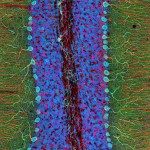Link to Pubmed [PMID] – 19651532
Cytokine Growth Factor Rev. 2009 Aug;20(4):283-95
Immune recognition of virus-associated molecules by Toll-like receptors (TLRs) and/or RIG-I-like receptors (RLRs) triggers intracellular signaling cascades that converge on the activation of interferon regulatory factors – particularly IRF3 and IRF7, leading to the transcriptional induction of type 1 interferon genes. This review summarizes new data describing how these factors regulate the temporal and quantitative differences in the expression of the multigenic IFN-A family. The distinctive DNA-binding features of IRF3 and IRF7 affect the selectivity and affinity of these factors for IFN-A promoters; modification of the ratio of promoter-bound IRF3 and IRF7 during virus infection may influence both transcriptional activation and repression of IFN-A genes. This review also summarizes the structural differences between IFN-beta and different IFN-alpha subtypes, their interaction with their common receptor IFNAR, and their potency to elicit antiviral, antiproliferative and antitumoral responses. Taken together, this information enhances our understanding of the selective advantage of the multiplicity of IFN-alpha subtypes in the regulation of innate and adaptive immunity.

